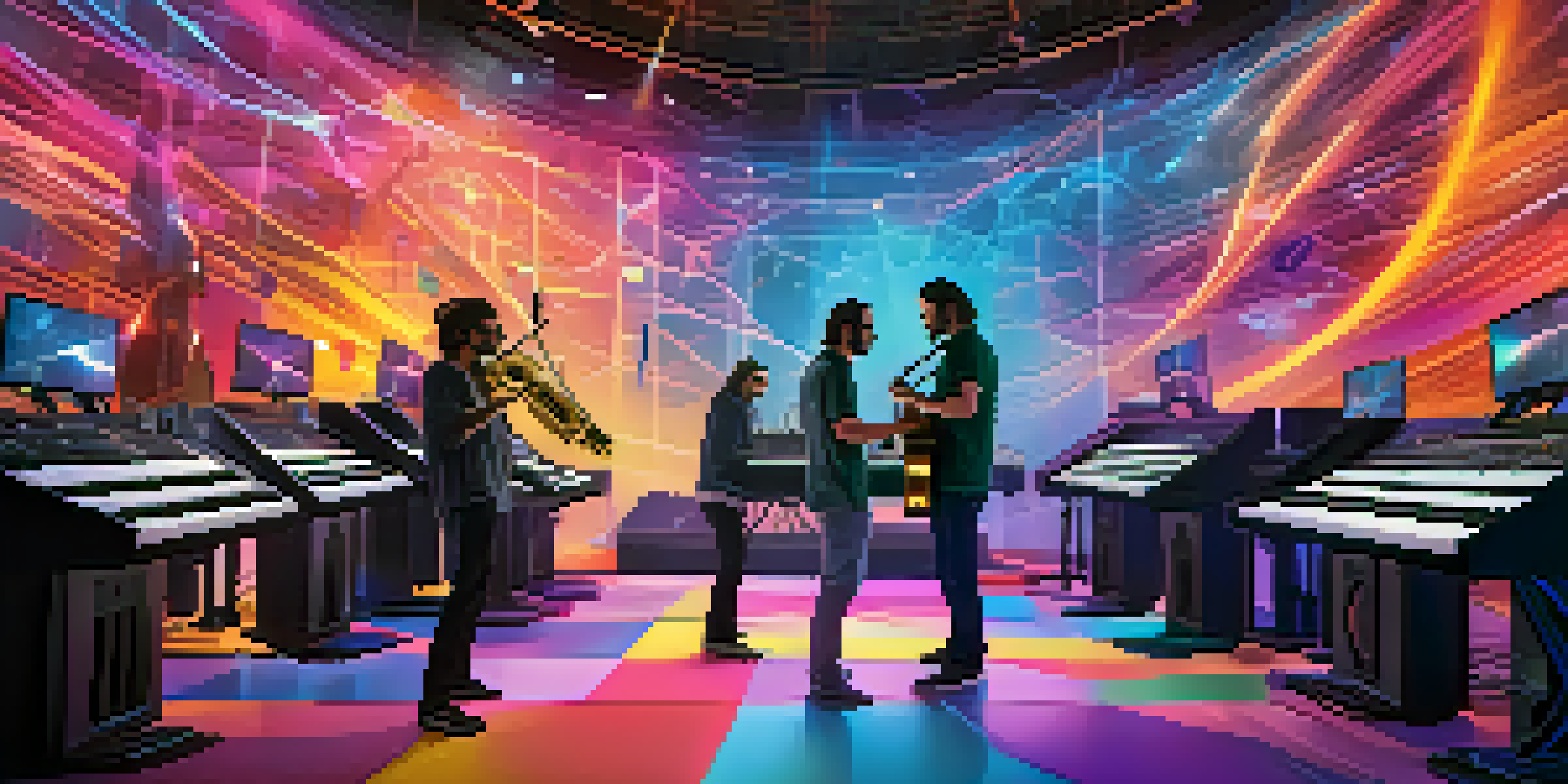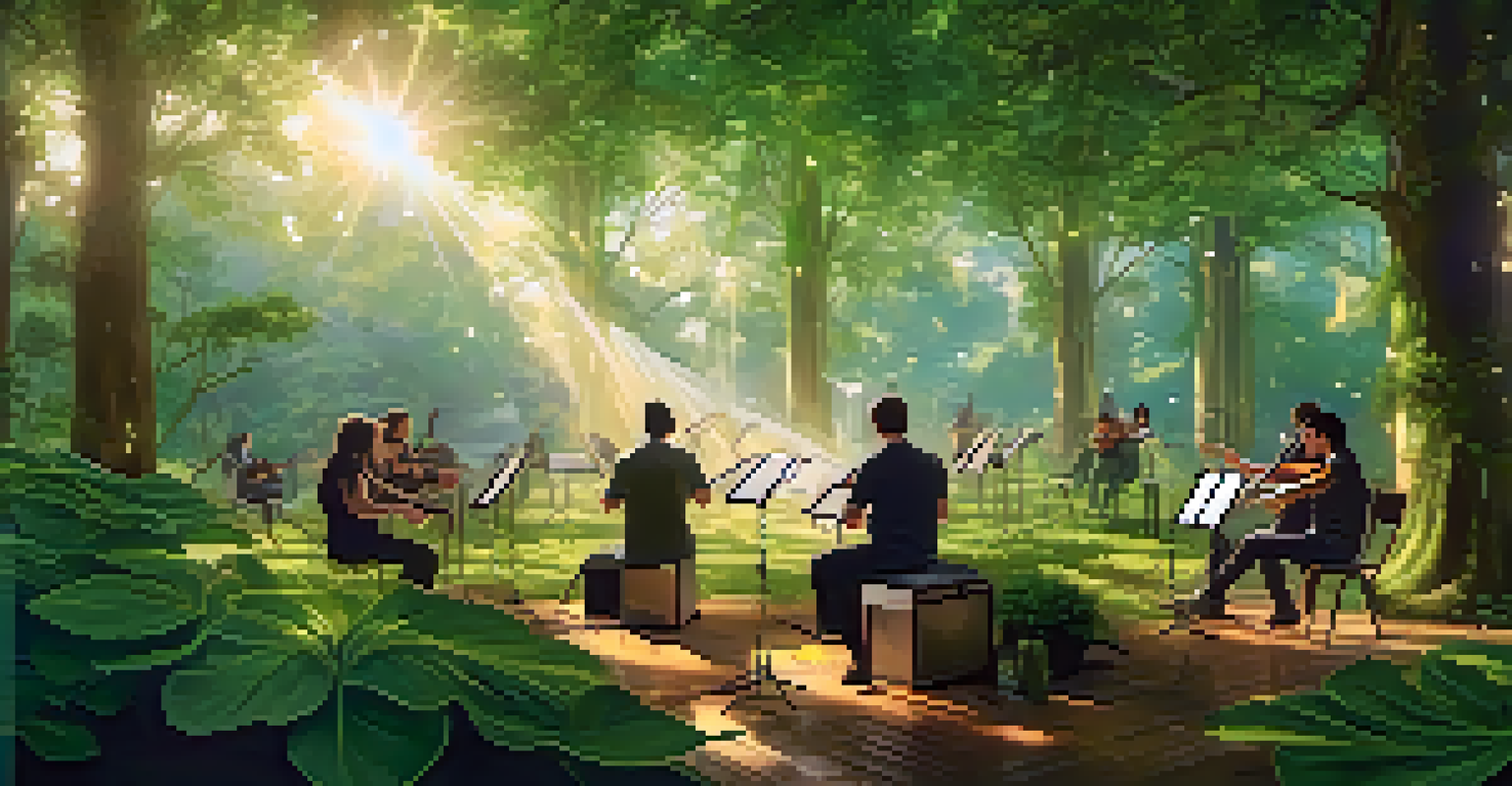The Future of Music Collaborations via Virtual Reality

Introduction: The Intersection of Music and Virtual Reality
In the digital age, music collaboration has taken on new dimensions, largely thanks to technology. Virtual reality (VR) is now emerging as a powerful tool that can enhance the way musicians connect and create together. Imagine jamming with a bandmate across the globe while feeling like you’re in the same room. This article explores how VR is shaping the future of music collaborations.
Music can change the world because it can change people.
As artists strive to push creative boundaries, the immersive experiences offered by VR present a unique opportunity. It’s not just about playing together; it’s about creating a shared space that fosters collaboration and innovation. Through VR, artists can visualize their ideas, experiment with soundscapes, and interact in real time, which can lead to groundbreaking music.
The potential for VR in music is vast, and its adoption is already gaining traction. From virtual concerts to collaborative songwriting sessions, VR is setting the stage for a new era of musical expression. Let’s dive deeper into how these technologies are changing the landscape of music collaboration.
The Rise of Virtual Reality Platforms for Musicians
Several VR platforms are now catering specifically to musicians and creators, providing tools that allow for seamless collaboration. These platforms offer virtual studios where artists can meet, brainstorm, and create together, regardless of their physical location. Think of it as a digital playground where creativity knows no bounds.

One such example is Oculus Venues, which allows artists to perform live in a virtual space while fans join in from anywhere in the world. This not only enhances the concert experience but also opens doors for real-time collaboration with other musicians. It’s like bringing a jam session to a global audience in the blink of an eye.
VR Enhances Global Music Collaboration
Virtual reality breaks down geographical barriers, allowing musicians from around the world to collaborate as if they were in the same room.
As these platforms continue to evolve, we can expect even more features designed specifically for musicians. The integration of AI and machine learning could lead to smarter tools that suggest musical ideas or help refine compositions, making collaboration easier and more intuitive than ever.
Enhanced Creative Spaces: How VR Inspires Collaboration
One of the most exciting aspects of VR is its ability to create immersive environments that inspire creativity. Imagine walking through a virtual forest while crafting a song or floating through a cosmic space as you compose a track. These environments can spark new ideas and push artists out of their comfort zones.
The future belongs to those who believe in the beauty of their dreams.
In VR, musicians can visualize their music in three dimensions, allowing them to experiment with sounds in ways they never could before. This spatial awareness can lead to innovative arrangements and unique compositions that may not have been possible in a traditional studio setting. It’s a whole new way to experience the creative process.
Furthermore, the ability to collaborate in these creative spaces fosters a sense of community among artists. They can share their thoughts and inspirations in real time, building on each other's ideas and creating something truly original. This synergy is a key driver of musical innovation in the VR landscape.
Bridging Distances: Collaborating Across the Globe
One of the biggest challenges for musicians has always been distance. However, VR is breaking down these barriers, allowing artists from different corners of the world to collaborate as if they were in the same room. This opens up a world of possibilities for cross-cultural music blending.
For instance, a musician in New York can team up with a producer in Tokyo, merging their styles and creating a unique sound that reflects both cultures. Such collaborations can lead to fresh genres and innovative music that might never have been born in isolation. The world truly becomes a stage for creative expression.
Immersive Environments Inspire Creativity
VR creates unique immersive spaces that spark new ideas and encourage innovative music compositions.
Moreover, these global collaborations can also foster understanding and appreciation of diverse musical traditions. As artists share their backgrounds and influences, they not only create music but also build connections that transcend borders. This cultural exchange enriches the entire music landscape.
The Role of Artificial Intelligence in Music Collaboration
Artificial intelligence (AI) is increasingly playing a role in music creation, and when combined with VR, the possibilities are limitless. AI can analyze a musician’s style and suggest complementary sounds or rhythms, enhancing the collaborative process. This technology acts as a creative partner, pushing the boundaries of what’s possible.
For example, an AI tool could help artists brainstorm lyrics or generate backing tracks, making it easier for collaborators to focus on their strengths. By using AI as a resource, musicians can streamline the creative process and experiment with new ideas without feeling overwhelmed. It’s like having an ever-present assistant in the studio.
As AI continues to evolve, we can anticipate even more sophisticated tools that adapt to individual artists' styles and preferences. This could revolutionize how collaborations are approached, making it simpler for musicians to come together and create music that is truly unique and reflective of their combined talents.
Challenges and Considerations in Virtual Music Collaborations
While the future of music collaborations via VR looks promising, there are challenges that artists need to consider. For one, the technology can be expensive and may not be accessible to all musicians. This creates a disparity in opportunities for collaboration, which is something the industry must address.
Additionally, technical issues such as latency can affect real-time collaboration, leading to frustrations during the creative process. Imagine trying to play in sync with someone who is half a second behind; it can disrupt the flow and creativity. Finding solutions to these challenges will be crucial for widespread adoption.
AI Revolutionizes Music Creation
The integration of artificial intelligence in VR can streamline the creative process, helping musicians collaborate more effectively.
Moreover, as with any technology, there’s the question of how it impacts the authenticity of music. Artists may worry that relying too much on virtual tools could dilute their unique sound. Balancing the use of technology with genuine artistic expression will be essential as VR becomes a more integral part of music collaboration.
Conclusion: The Future is Bright for VR Music Collaborations
As we look to the future, it’s clear that virtual reality is set to redefine music collaborations in extraordinary ways. From breaking down geographical barriers to fostering creative environments, VR offers tools that can elevate the music-making process. Artists are now empowered to explore new realms of creativity like never before.
The potential for collaboration is vast, encompassing not just musicians but also fans who want to engage in the process. Virtual concerts and interactive sessions can create a community where everyone participates in the music creation journey. This sense of connection can lead to a richer musical experience for all involved.

In summary, while there are challenges to overcome, the innovative possibilities that VR brings to music collaboration are too exciting to ignore. As technology continues to advance, we can expect to see even more groundbreaking ways for artists to connect, create, and inspire through music.